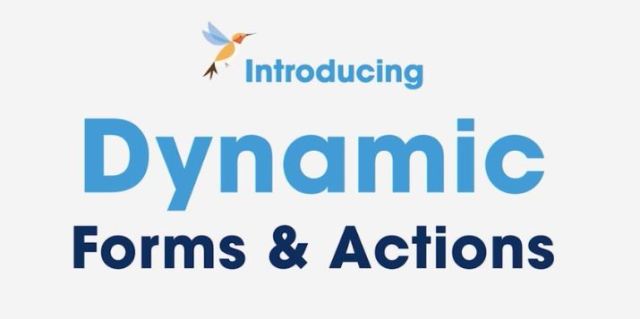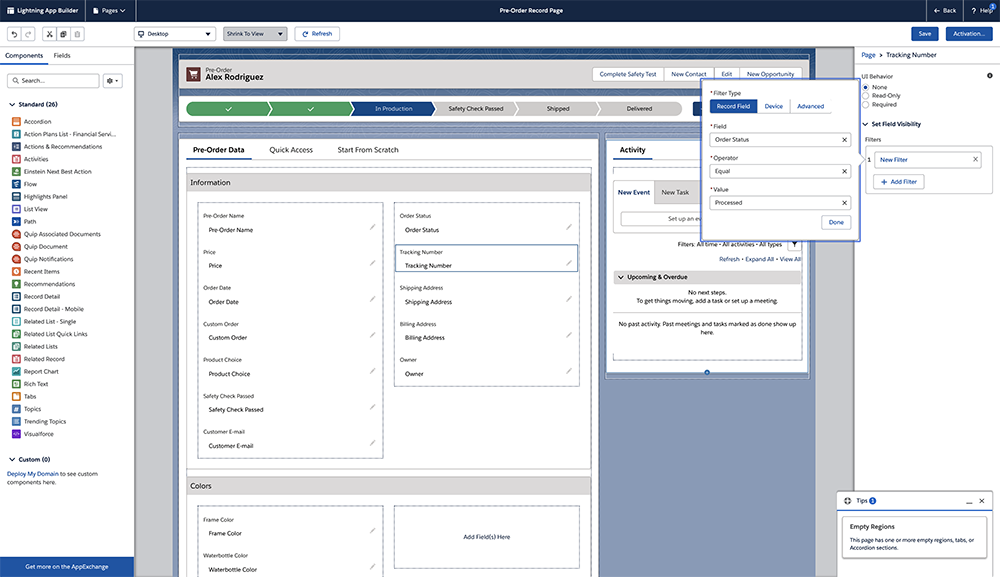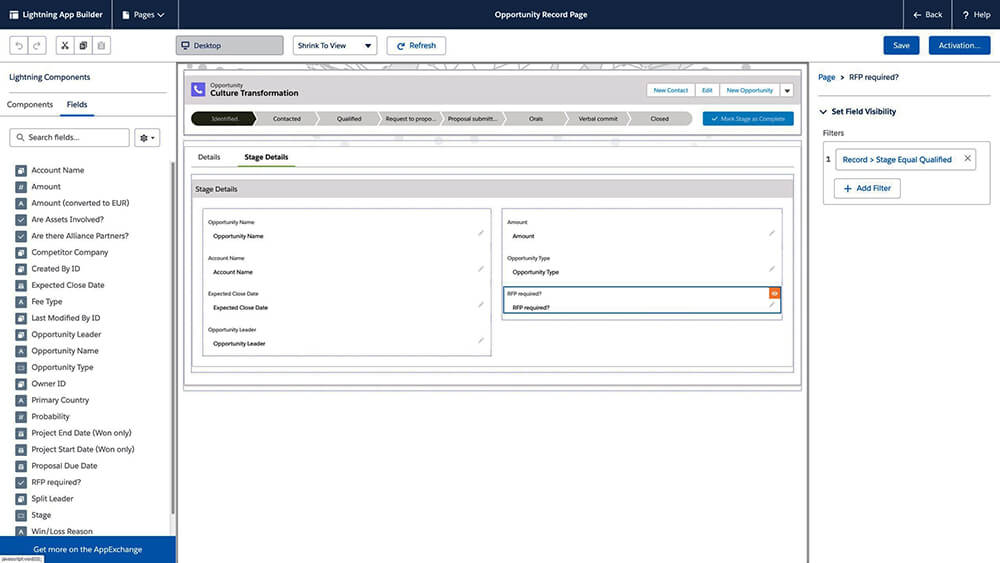
Dynamic Forms & Actions
Organizations must build apps fast to respond to evolving business and economic changes. This is where the Salesforce Platform shines power, enabling everyone to innovate fast and scale with confidence using low-code builders. Drag, drop, and deliver modern apps that increase employee productivity with Lightning App Builder. Automate processes that improve operational efficiency with Flow Builder. Ultimately, delight every employee and customer with modern experiences that do not sacrifice enterprise quality, all without having to code.
Salesforce delivering part of Summer 20′ two highly requested capabilities to Lightning App Builder—Dynamic Forms and Dynamic Actions.

What are Dynamic Forms and Dynamic Actions?
Dynamic Forms transform static data entry forms into intuitive experiences. With Dynamic Forms, every engagement is data-driven and responsive to user input in real-time. Dynamic Actions further guide employees through the experience with clear next steps. Together, these features will empower businesses to easily build and scale productive, engaging experiences that surface the right information at the right time to the right person, all without having to code.

Why are Dynamic Forms and Dynamic Actions Important?
Dynamic Forms and Actions are important for every company looking to digitally transform and embrace modern architectures. Apps of the past were static, trigger-based, batch updated and hardcoded. Apps of today are dynamic, event-driven, real-time, and responsive. Dynamic Forms and Dynamic Actions further the power of the Salesforce Platform with its integrated event, identity, and security model and its ability to build apps from components that serve as interchangeable building blocks. Dynamic Forms and Dynamic Actions can also be combined with other platform services, including Flow, Einstein, Mobile, and Collaboration, to unlock a composable enterprise’s possibilities.
Automation by Flow Builder has been surging on the Salesforce Platform. In March 2020, the Salesforce Platform had 325B+ processes automated, an increase of 25% YOY, and 161M+ visual screen flows launched, an increase of 83% YOY, to help with repetitive tasks like closing cases or onboarding new hires. This helps increase productivity and data quality and provides guardrails that support compliance and security.

How do Dynamic Forms and Dynamic Actions Work?
With Dynamic Forms, fields and sections can be placed anywhere on the page to effectively structure and organize the information. Further, rules can be set to only show certain fields based on other field values, such as when a checkbox is selected or when a picklist has a certain value. Experiences can be personalized further by only showing data to people based on their role, location, or other identifying information.
Dynamic Actions allows for control of the set of next steps or actions available in an experience. As with Dynamic Forms, rules can be set for when actions are shown based on field values or user information. This ensures people only see actions relevant to them at the right time.
Here’s an example of how these innovative capabilities can be used. Job candidates provide multiple documents and pieces of information when applying for a role—including salary information, resumes, job history, legal status, and references—but not everyone in the hiring process needs to see it all. With Dynamic Forms, visibility rules will surface different candidate information to the recruiter, HR department, hiring manager, and interviewers. And with Dynamic Actions, specific actions get assigned to each person involved in the hiring process to ensure they are aware of the next steps to move the candidate along. After the candidate is hired, users can leverage flow automation to create an onboarding journey that helps hiring managers to assign the right equipment to their new hire, provide them with the necessary training and give them credentials to access online tools.
“This is huge,” said Amber Boaz, Trailblazer and Salesforce MVP. “Dynamic Forms and Actions will allow me to create pages once and reuse them multiple times, all without any custom coding, managing permissions, or moving between environments to get an app built. This won’t just make my life easier — it will make my organization more efficient overall.”
“Dynamic Forms and Dynamic Actions are significant innovations on Lightning App Builder,” said Larry Carvalho, Research Director, Platform as a Service, IDC, “These tools will allow users to easily create dynamic pages by removing the need for duplicative work and enable businesses to deploy solutions faster and at a lower cost.”
Dynamic Forms benefits you in these ways.
- An instant upgrade from page layouts: Place fields and sections wherever you want.
- Better page performance: Put fields and sections into accordion components or tabs to significantly improve page load times.
- Dynamic layouts: Use visibility rules to show and hide fields and sections.
- Simpler layout management:
- Manage the fields and sections on your pages in the Lightning App Builder without touching the page layout editor.
- Reduce the number of page layouts you need with component visibility rules.
- Take advantage of a single assignment model for the Lightning page instead of the dual model of assigning a Lightning page and a page layout.

How: To enable Dynamic Forms in your org, from Setup, enter Record in the Quick Find box, and then click Record Page Settings. In the Dynamic Forms section, flip the switch to On.
Dynamic Forms is a Non-GA Preview and has limitations. We recommend that you read all the information in the Dynamic Forms section of the Record Page Settings page before you enable this feature.
After you enable Dynamic Forms, new features appear in the Lightning App Builder. A new Fields tab in the component palette contains Field and Field Section components, which are the building blocks for Dynamic Forms.
How do you get started? Open an existing record page in the Lightning App Builder, then click Upgrade Now from the Record Detail properties pane to launch the Dynamic Forms migration wizard. With only a few clicks, the wizard adds fields and field sections to the page for you.

Dynamic Actions to the Highlights Panel for Custom Objects
You can use the Lightning App Builder instead of the page layout editor to choose which actions appear in the Highlights Panel on the object’s record page. Control visibility for each action based on factors that you specify.
you can use the Lightning App Builder instead of the page layout editor to choose which actions appear in the Highlights Panel on the object’s record page. Control visibility for each action based on factors that you specify.
To add an action, click Add Action (3). In the Actions modal, choose an action (4) and click Add Filter (5) to assign visibility rules. You can specify action visibility based on the record field, device type, and other filters to control which actions appear for which users.

Thanks for Reading..